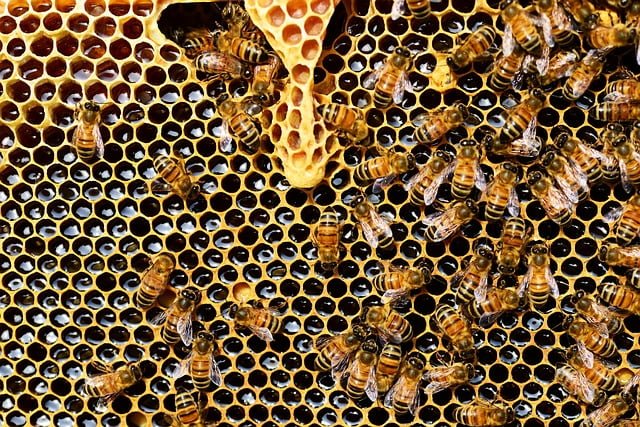
Honeycomb & Hexagons: Nature’s Perfect Shape?
by Bettina Mueller-Tuescher, Curious Content Team
Humans have long been fascinated with the mathematical precision and sophistication bees display when building honeycomb. Somehow, they consistently build in a perfectly hexagonal pattern to store larvae, pollen, and honey. But, while it’s a highly efficient use of space, building honeycomb is incredibly work-intensive.
A colony of bees must consume eight pounds of honey in order to create one single pound of wax. To create one pound of honey, a colony needs to visit roughly 2 million flowers, which usually results in around 55,000 miles of collective travel – that’s 16 million flowers and 440,000 miles of travel for just one pound of wax! And to put matters further into perspective, one bee creates only about 1.5 teaspoons of honey in her lifetime of about four to six months. Translation: it would take 267 bees their collective lives to make one pound of honeycomb.
So, why do bees exert so much time and energy making wax to build honeycomb in such a particular way?
Over two thousand years ago in 36 BCE, Roman scholar Marcus Terentuis Varro proposed an explanation for what is now known as “The Honeycomb Conjecture.” Varro stated that the hexagon is one of the only three shapes that tessellates, and thus allows for economy of space and labor when building the comb. But why not build honeycomb in a triangular or square configuration? Although he couldn’t figure out how to prove it mathematically, Varro believed the hexagon to be the most compact shape, having the largest interior space with the smallest perimeter.
Charles Darwin too, was struck by the honey bee and its sophisticated building techniques. He conducted many of his own studies specifically around bees (or “humblebees,” as he often called them,) and how they build their hives. For his theory of evolution to be taken seriously, Darwin realized that he would need an explanation for the bee’s ability to build honeycomb: “so wonderful an instinct as that of the hive-bee making its cells will probably have occurred to many readers, as a difficulty sufficient to overthrow my whole theory.” Though he recognized the immense evolutionary adaptability in bees, Darwin couldn’t explain precisely why they used the hexagonal structure any more than Varro already had. In fact, it wasn’t until 1999 that mathematician Thomas Hales was able to produce a mathematical formula proving Varro’s “Honeycomb Conjecture,” was true.
It’s remarkable that bees evolved to build honeycomb with such mathematical precision, particularly since it took humans until eighteen years ago to be able to concretely prove what bees were able to intuit thousands of years ago.
Today, beekeepers have found ways to enable bees to cut back on the labor involved in building comb, so they can allocate more of their efforts towards honey production. The most common method for doing this is to provide a rectangular box filled with frames; each frame holding a sheet with the outline of a honeycomb structure. Sometimes the frame holds merely an outline, allowing bees to trace over the lines with their own wax, and sometimes the template is shaped like fully formed and ready to use comb. While bees normally still build off the provided comb to fit their own tastes, they are free to direct their energy more heavily towards honey production.